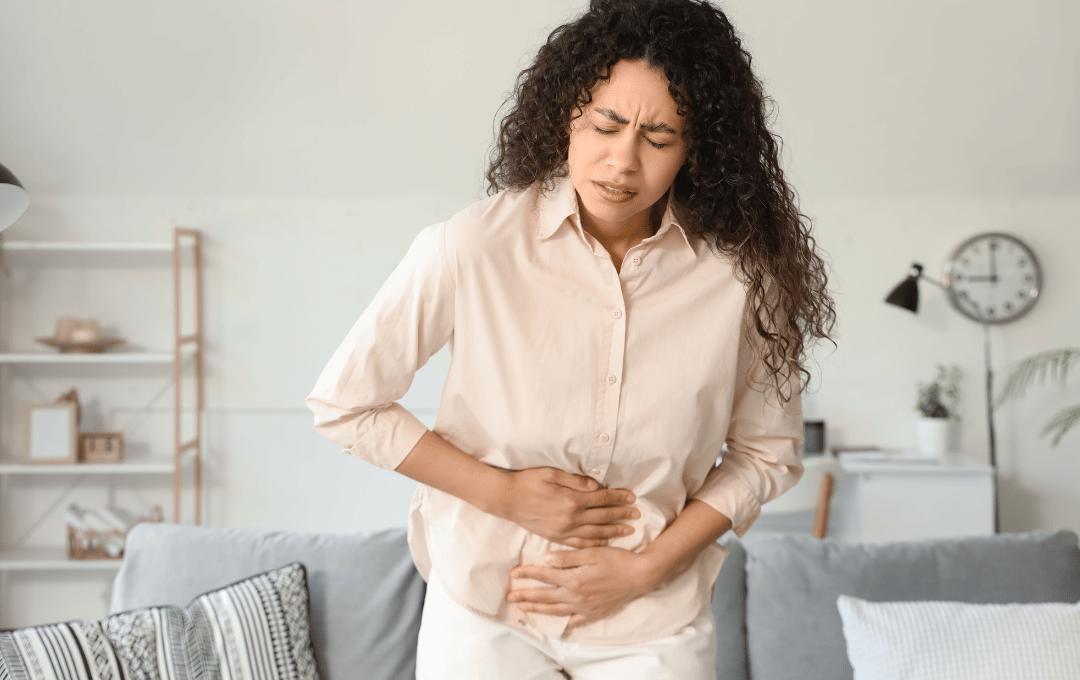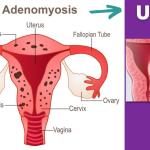
Living with adenomyosis can mean dealing with pain that ranges from uncomfortable to unbearable. Since its symptoms mimic those of other conditions, like endometriosis or fibroids, adenomyosis is often misdiagnosed or overlooked.
Understanding the nature and causes of adenomyosis pain can help you recognize when it may be a sign to seek professional evaluation and treatment.
Why Does Adenomyosis Cause Pain?
Adenomyosis pain occurs when endometrial tissue (uterine lining) grows into the muscular wall of the uterus. This misplaced tissue thickens the uterine wall, triggers inflammation, and leads to chronic pelvic pain and heavy bleeding.
The extra tissue growth continues to respond to hormonal changes each month, often leading to:
- Increased uterine pressure
- Swelling and inflammation
- Trapped menstrual blood inside the muscle wall
These changes can enlarge the uterus and irritate surrounding nerves and tissue. Pain from adenomyosis may feel sharp and stabbing, dull and achy, or like intense menstrual cramps.
When Is Adenomyosis Pain Worse?
Although pain from adenomyosis can occur at any time, there are specific factors that can make it even worse.
Some of these factors include:
- Age and Menstrual History: Women in their 40s and 50s with adenomyosis are more likely to experience chronic pain. Shorter menstrual cycles or prolonged estrogen exposure can increase symptom severity.
- Pregnancy and Childbirth: Women who have had multiple pregnancies or complicated childbirths may be at higher risk. Uterine trauma can trigger flare-ups and more frequent adenomyosis pain.
- Uterine Surgery: Procedures such as cesarean births or fibroid removal surgeries, such as myomectomies, can alter uterine tissue, which can contribute to the development of adenomyosis.
- Hormonal Fluctuations: Shifts in estrogen and progesterone during menstruation, pregnancy, or while using certain contraceptives can increase adenomyosis pain, impacting inflammation and the uterus’s response from one month to the next.
Other factors like chronic stress, coexisting conditions such as fibroids or endometriosis, and general inflammation can also contribute to adenomyosis symptoms. If you’re unsure whether you’re experiencing symptoms of adenomyosis, fibroids, or another uterine condition, take our symptom quiz below.
What Is the Pain Scale for Adenomyosis?
Adenomyosis pain varies widely in intensity, often ranging from mild discomfort to severe pain. Many patients scale their pain as moderate to severe, but it’s important to understand that adenomyosis pain is not limited to just the uterus. It can impact multiple areas of the pelvic region and other areas of the body, and its intensity can fluctuate significantly.
These differences in pain areas are related to the formation of adenomyosis within the uterus. Typically, adenomyosis pain occurs in two types of forms: diffuse and focal.
- Diffuse adenomyosis pain involves a widespread growth of endometrial tissue within the uterine walls, leading to broader, more generalized pain throughout the pelvis or lower abdomen and increased overall pain.
- Focal adenomyosis pain results from concentrated areas of tissue mass or thickened muscle growth that trigger intense, localized cramping or pressure in a specific region.
As the condition progresses, the nature and intensity of pain can shift, making it harder to manage without proper treatment. Understanding the types of adenomyosis pain can help you better identify patterns and communicate your symptoms to an interventional radiologist.
Below are common locations where pain from adenomyosis may occur.
Adenomyosis Chronic Pelvic Pain
Adenomyosis can cause chronic pelvic pain that feels like ongoing menstrual cramps but is more persistent. Many describe it as a deep, heavy pressure in the lower abdomen. Bloating or a sense of fullness may accompany this chronic pelvic pain.
Adenomyosis Back Pain
Due to the proximity of the uterus to the lower back and pelvic nerves, pain can radiate to the lumbar region. This adenomyosis back pain often resembles sciatica or a dull, persistent ache. It can also impact the groin, inner thighs, and hips, extending down to the legs.
Adenomyosis Leg Pain
Adenomyosis can cause leg pain due to nerve pressure or inflammation stemming from the uterus, which may feel like aching in the thighs. It may also feel like a sharp and persistent pain if it is associated with adenomyosis-related back pain.
Chronic Adenomyosis Pain
Some individuals experience adenomyosis pain all the time, with fluctuating intensity. This constant pain is often a result of ongoing inflammation and tissue damage, leading to swelling. Over time, the discomfort can interfere with daily routines, work, and sleep. Chronic adenomyosis pain usually cannot be managed with over-the-counter pain medication and often requires medical treatment to effectively relieve discomfort.
Does Adenomyosis Cause Pain When Not Menstruating?
Adenomyosis can cause pain, even when you’re not menstruating. While the pain often peaks during menstruation, many individuals still experience it at various points throughout the month. Adenomyosis pain may increase during ovulation or persist due to constant uterine irritation. In extreme cases, adenomyosis pain can become nearly continuous.
How to Tell if You’re Experiencing Pain from Adenomyosis
Adenomyosis shares many symptoms with other uterine conditions like fibroids, ovarian cysts, or pelvic inflammatory disease.
An interventional radiologist can confirm whether you have adenomyosis through diagnostic tools and techniques such as:
- Pelvic ultrasound or MRI
- Medical history review
- Exclusion of other causes
If you’re experiencing persistent pelvic pain, heavy menstrual bleeding, or pain during sex, consult an interventional radiologist for a diagnosis and to discuss a personalized treatment plan to alleviate adenomyosis pain.
Schedule Your Consultation Today
How to Relieve Pain from Adenomyosis
Managing adenomyosis pain requires a combination of symptom relief and treatment plans that address the condition itself. While temporary adenomyosis pain management strategies can provide short-term relief, a comprehensive diagnosis and professional treatment are recommended for lasting relief.
UAE Treatment for Adenomyosis Pain
Uterine artery embolization (UAE) is a non-surgical, minimally invasive treatment that blocks blood flow to the affected uterine tissue, reducing inflammation and bleeding. It effectively alleviates symptoms without the need for surgery, such as a hysterectomy.
Many women experience long-term relief from adenomyosis and chronic pain after uterine artery embolization. A consultation with an interventional radiologist can help determine whether UAE is the right treatment option based on the severity of your symptoms and other factors.
Get Relief From Adenomyosis Pain with USA Fibroid Centers
It’s important not to ignore persistent or worsening adenomyosis chronic pain. With accurate diagnosis and tailored treatment, many individuals find relief from painful and disruptive symptoms.
USA Fibroid Centers’ experts provide diagnostic support and a minimally invasive solution, uterine artery embolization, to effectively treat adenomyosis pain and prevent the condition from progressing.
Book a consultation today at USA Fibroid Centers and take the first step toward relieving pain from adenomyosis.
FAQs About Adenomyosis Pain
What Does a Pain Flare-Up from Adenomyosis Feel Like?
An adenomyosis pain flare-up can feel like sharp, knifelike pelvic pain with a dull ache in the groin, lower back, thighs, or hips. It may also cause severe cramping, making it difficult to move or contribute to nausea.
How Long Does a Typical Adenomyosis Pain Flare Last?
Adenomyosis pain flares can last from hours to days or even weeks, with the pain being intermittent or constant, mild or severely debilitating.
What Can Trigger Adenomyosis Pain Flares?
Adenomyosis pain flares can be triggered by hormonal fluctuations, especially increased estrogen during the menstrual cycle, as well as stress, poor sleep, certain inflammatory foods, and activities that strain or put pressure on the pelvic area, such as heavy lifting, intense exercise, or intercourse.
How Does Adenomyosis Pain Affect Sexual Health or Intimacy?
Adenomyosis can affect sexual health and intimacy by causing painful intercourse (dyspareunia), bleeding after sex, and post-coital cramping. These types of adenomyosis pain can lead to reduced libido, emotional distress, and anxiety related to sexual intimacy.
Can Adenomyosis Cause Pain During Ovulation?
Adenomyosis can cause pain during ovulation. The release of the egg and related hormonal shifts can irritate the inflamed uterine tissue, leading to sharp or cramping pain in the pelvis or abdomen.
How Can I Relieve Pain from Adenomyosis Temporarily?
Temporary adenomyosis pain management strategies include:
- NSAIDs (e.g., ibuprofen) to reduce inflammation and pain
- Hormonal treatments like birth control pills, IUDs, or hormone therapy
- Lifestyle adjustments, including stress reduction, dietary changes, and regular exercise
These methods can provide short-term relief, but a proper diagnosis and professional treatment are recommended for lasting relief.




